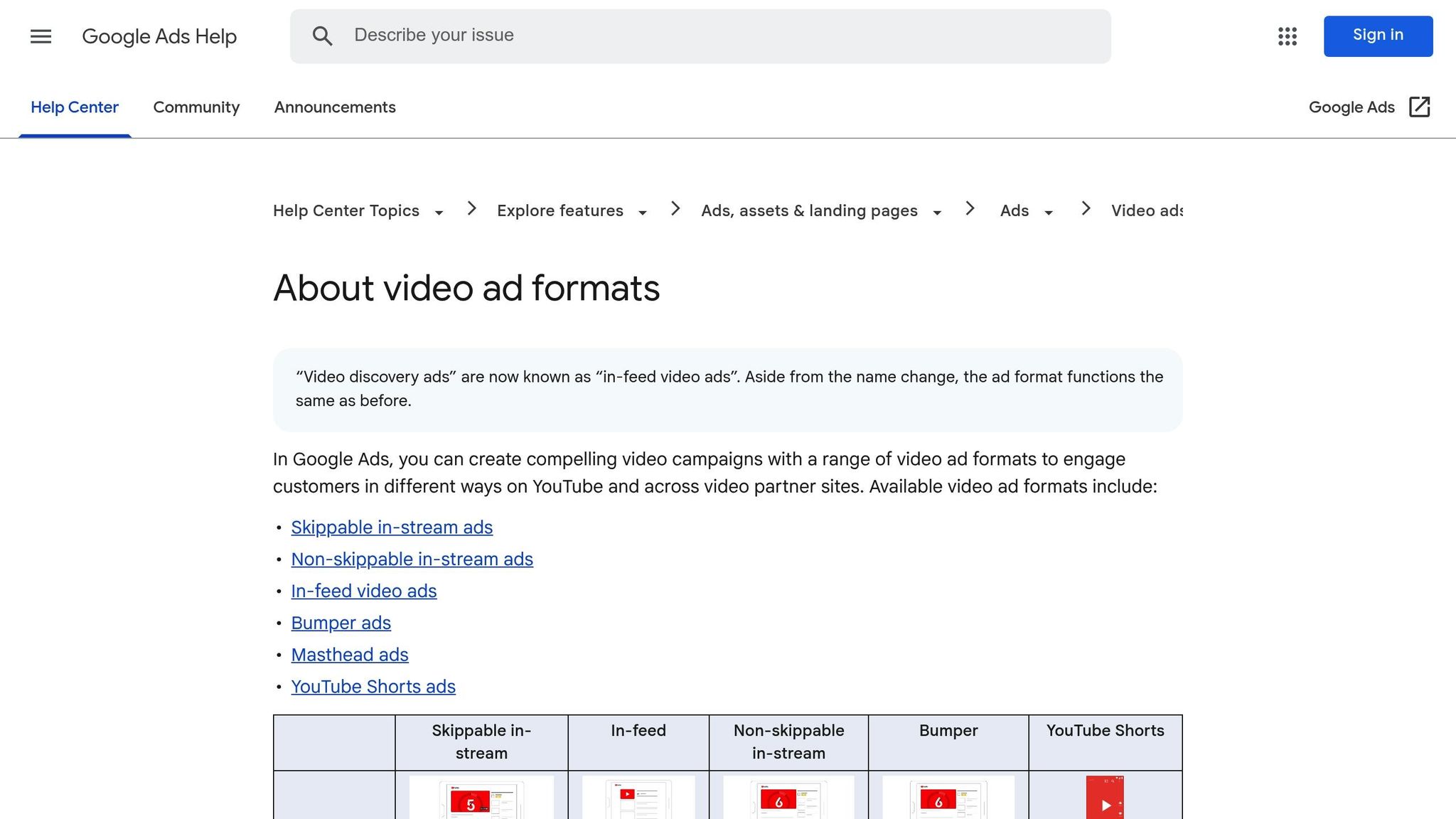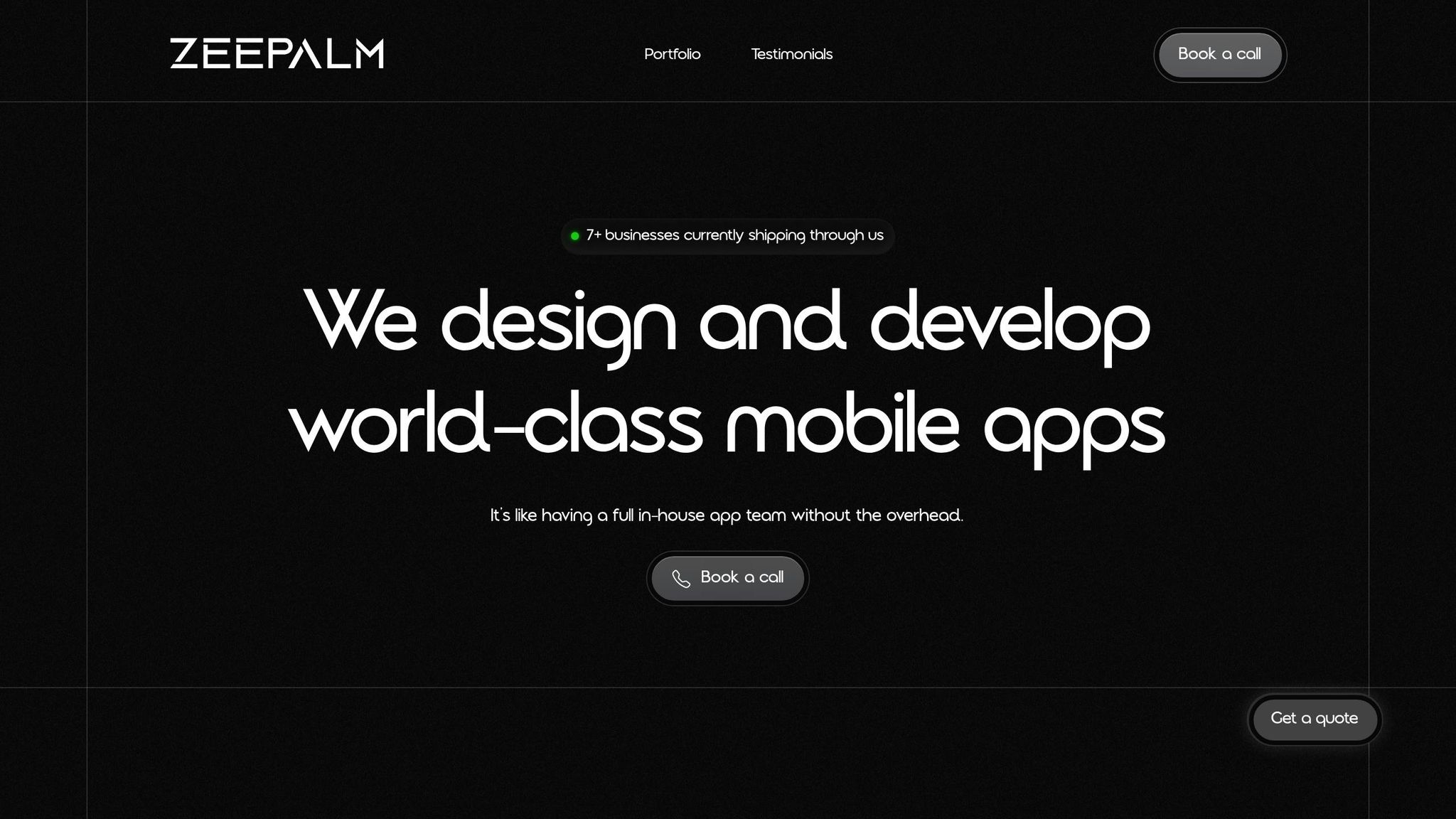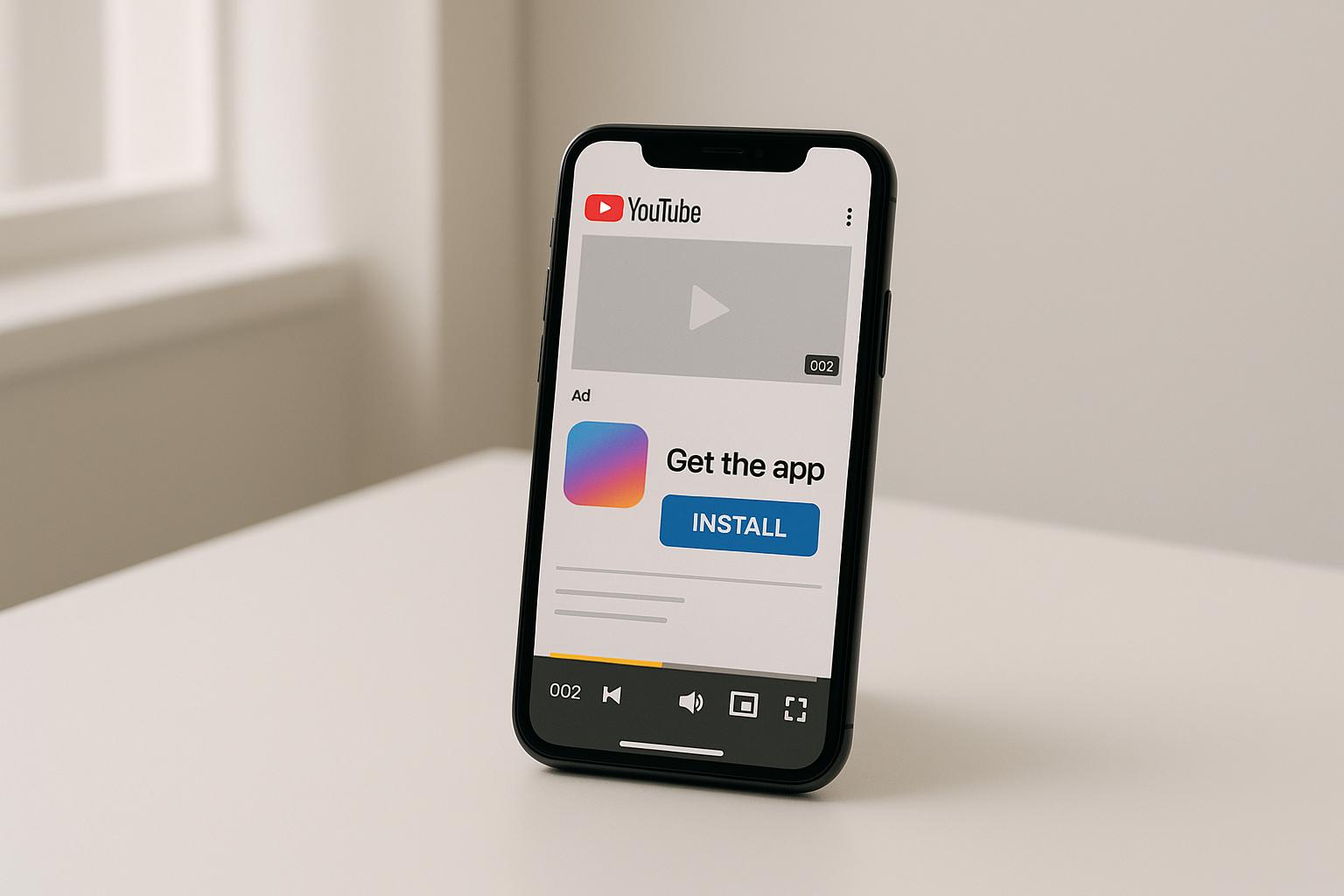YouTube Ads are a powerful way to promote mobile apps, thanks to their massive reach and focus on video content. With over 2.5 billion monthly users and 1 billion hours of video watched daily, YouTube offers app developers a chance to showcase their app’s features and drive downloads effectively. Here's what you need to know:
- Why YouTube Works for Apps: Video content engages users better than static ads, increasing download likelihood by 80%. Plus, YouTube influences 70% of users to make purchase decisions after watching product-related videos.
- Ad Formats: Skippable ads (TrueView) are great for detailed demos, non-skippable ads ensure the full message is seen, and discovery ads target users actively searching for solutions.
- Key Metrics: Focus on app installs, cost per install (CPI), retention rates, and in-app engagement to measure campaign success.
- Optimization Tips: Use deep linking, refine audience targeting, and test creative assets to improve performance.
YouTube Ads offer a cost-effective way to connect with global audiences, leveraging Google’s advanced targeting to drive app installs and user engagement. Ready to maximize your app’s potential? Let’s dive into the details.
How to get More App Installs With Youtube ( App Marketing Strategy )
YouTube Ad Formats for App Downloads
Choosing the right YouTube ad format can make a big difference when it comes to driving app installs. Each format serves a specific purpose and works best for different goals and budgets. By understanding how these formats work, you can make the most of your advertising budget and target users who are more likely to download your app. Let’s break down the options and how they can help you achieve your goals.
Skippable In-Stream Ads (TrueView)

Skippable in-stream ads let viewers skip after 5 seconds, and you only pay when someone watches at least 30 seconds - or the full ad for shorter videos - or interacts with it. This cost-per-view model is a smart way to drive app installs without overspending. To make the most of those critical first 5 seconds, showcase your app’s standout feature. Whether it’s the action-packed gameplay of your latest mobile game, a time-saving tool, or a unique way to connect socially, grab attention fast. These ads work across all devices, making them versatile and effective.
Non-Skippable In-Stream Ads and Bumper Ads
Non-skippable in-stream ads are 15–20 seconds long (up to 30 seconds on connected TVs) and must be watched in full before the viewer can proceed. This ensures your entire message is seen, making it ideal for emphasizing key features or demonstrating how your app solves a problem.
Bumper ads are even shorter - just 6 seconds - but their brevity is perfect for building brand recall and supporting remarketing efforts. According to industry stats, interstitial ads - similar to non-skippable YouTube ads - boast conversion rates of over 20% on Android and nearly 15% on iOS. This suggests that requiring users to watch your complete message can significantly boost action rates. Both formats are available across devices, including computers, mobile phones, TVs, and game consoles.
Video Discovery Ads
Video discovery ads are displayed in YouTube search results, on the homepage, and next to related videos. Unlike in-stream ads, these rely on viewers opting in by clicking the thumbnail, which often results in higher-quality traffic for app downloads.
This format works particularly well for users actively searching for solutions that your app provides. For instance, if someone searches for “budget tracking apps” and your finance app appears as a discovery ad, they’re more likely to click, download, and try it out.
Discovery ads also blend seamlessly into the YouTube environment, appearing alongside organic content recommendations. This natural placement makes them feel less like ads and more like helpful suggestions, which is especially useful in competitive app categories where potential users tend to research before committing to a download.
Here’s a quick comparison of these ad formats:
| Ad Format | Length | Skippable | Best For | Payment Model |
|---|---|---|---|---|
| TrueView In-Stream | Flexible | After 5 seconds | Detailed app demos, storytelling | Pay per view (30+ seconds) |
| Non-Skippable In-Stream | 15–20 seconds | No | Quick feature highlights, brand awareness | Pay per impression |
| Bumper Ads | 6 seconds | No | Brand recall, remarketing | Pay per impression |
| Video Discovery | Flexible | User chooses to watch | Targeting active searchers | Pay per click |
Each format plays a unique role in a well-rounded app promotion strategy. TrueView ads are ideal for telling your app’s story or explaining its features in depth. Non-skippable ads are great for delivering short, impactful messages, while discovery ads shine when targeting users who are already searching for solutions like yours.
How to Set Up a YouTube App Install Campaign
If you're ready to tap into the power of YouTube ads, here's a straightforward guide to setting up your YouTube app install campaign using Google Ads. These steps will get you started in no time.
First, log in to your Google Ads account and head over to the "Campaigns" page. Click the plus (+) button and choose "New campaign".
Next, select "App promotion" as your campaign goal and pick "App installs" as the subtype.
From there, indicate whether your app is for Android or iOS.
Type your app's name, package name, or publisher details into the search bar. If it doesn’t appear, you can manually enter the app's URL - either the Google Play Store URL for Android or the App Store URL for iOS.
Finally, give your campaign a clear, descriptive name that includes the operating system for easy identification later.
Set Campaign Settings and Targeting
Create Video Ad Content
Track Conversions and Set KPIs
sbb-itb-8abf120
Improve and Measure Campaign Performance
After launching your YouTube app install campaign, it’s time to keep an eye on the data and make adjustments to optimize your results.
Important Metrics to Track
To understand how well your campaign is performing, focus on a few key metrics.
Start with app installs and cost per install (CPI) to evaluate how effectively your budget is being used. Keeping CPI low ensures your campaigns stay cost-efficient.
Another vital metric is user retention. With nearly half of all apps (47%) uninstalled within 30 days, low retention rates might suggest a mismatch between your app and the audience you’re targeting - or that the app experience doesn’t meet the expectations set by your ads.
Additionally, track in-app engagement metrics like account creation, first purchases, game level completions, or subscription sign-ups. These actions reveal the quality of users your campaign is attracting. Use conversion tracking to follow user behavior from the moment they click an ad to when they take meaningful actions within your app.
Ways to Improve Campaign Results
Boosting these metrics is crucial for turning viewers into loyal app users.
- Refine your bidding strategy: Align your bids with your campaign goals. For instance, focus on maximizing installs with a target CPI or aim for specific in-app actions with a target cost per action (CPA). Start with a daily budget of $50–$200 during an eight-week learning phase before scaling up.
- Optimize creative assets: Upload up to 10 text variations, 20 images, and 20 videos (10–30 seconds) in various aspect ratios. Regularly review performance and replace underperforming creatives using tools like the Ad Strength indicator.
- Implement deep linking: Direct users to specific app features to improve their experience. According to Google Data, advertisers using deep linking see, on average, more than double the conversion rate.
- Enhance audience targeting: Use YouTube’s segmentation tools to zero in on the right users. Target by demographics, interests, in-market audiences, and remarketing lists to attract users who are likely to engage long-term. Shifting focus from just acquiring installs to driving valuable in-app actions can improve user quality and retention.
Comparison of Improvement Methods
Not all optimization strategies require the same effort or deliver the same results. Here’s how they stack up:
- Bid adjustments and budget reallocation: These are relatively quick to implement and can yield moderate improvements.
- Creative testing: While resource-intensive, it often leads to significant performance gains over time.
- Deep linking and audience refinement: These strategies are particularly effective at attracting high-quality users and improving retention.
To get the most out of your campaigns, prioritize strategies based on your goals and resources. Start by focusing on deep linking and audience refinement, as these often deliver strong returns. Once you’ve nailed these basics, invest in creative testing to unlock even greater potential for your campaign.
Conclusion: YouTube Ads for App Downloads
YouTube ads are a powerful tool for driving mobile app downloads, offering the ability to showcase your app’s features in a dynamic, visual way that grabs attention far more effectively than text-based ads.
Main Points to Remember
To succeed with YouTube ads, it’s essential to understand the basics - choosing the right ad format, targeting your audience accurately, and using data to refine your approach.
Start by picking ad formats that fit your campaign’s goals. For instance, skippable in-stream ads work well for telling a detailed story about your app’s value, while bumper ads are ideal for short, impactful messages, especially in remarketing efforts.
Your ad’s creative elements play a critical role in performance. The first five seconds are make-or-break - use them to grab attention and highlight how your app solves a specific problem.
"Google's extensive data enhances ad targeting, so YouTube is a really attractive medium. The algorithm is very good at putting your ads in front of the right people at the right time."
– Chris Orzechowski, Marketing Consultant and Strategist, 100 Year Brand
Budgeting is another key factor. To give Google’s algorithm enough data to optimize, set your daily budget to at least 50× your target CPI. Many small businesses find success starting with daily budgets between $30 and $150, aiming for a solid return on investment. Let your campaigns run for at least a couple of months to gather enough data for meaningful insights.
Track metrics like app installs, CPI, user retention, and in-app engagement to continually fine-tune your campaigns and attract high-quality users.
With these strategies in place, you’ll have a solid foundation to take your app campaigns to the next level.
How Zee Palm Can Help Your App Campaigns

Running successful YouTube ad campaigns requires a mix of technical know-how and creative skill - areas where Zee Palm excels. With more than 10 years of experience, over 100 completed projects, and a team of 13 dedicated professionals, Zee Palm has the expertise to navigate the challenges of app marketing, from development to user acquisition.
We specialize in areas like AI, SaaS, and custom app development, as well as industries such as healthcare, EdTech, and social media platforms. This gives us a deep understanding of what drives success across various app categories. Our team collaborates closely with marketing experts to ensure your app is primed for conversions before launching any campaigns.
From setting up campaigns and targeting the right audience to producing engaging creative assets and optimizing performance, Zee Palm handles every aspect of your YouTube advertising strategy. We’re also well-versed in technical essentials like deep linking, conversion tracking, and iOS SKAdNetwork implementation - challenges that can be daunting for many businesses.
With a proven track record of over 70 satisfied clients, Zee Palm is your partner for avoiding common pitfalls and implementing strategies that deliver quality app installs and long-term user engagement.
Reach out to Zee Palm today to explore how we can help your app thrive with a tailored YouTube advertising strategy designed to meet your goals and connect with your audience.
FAQs
What is the best YouTube ad format for driving app downloads?
The best YouTube ad format for promoting your app depends on what you want to achieve. For quick downloads, skippable or non-skippable in-stream ads work well since they let viewers take immediate action. If you're looking to boost discovery and engagement, discovery ads can help users find your app through search results or recommendations.
Want to focus on brand awareness and make a memorable impact? Bumper ads - those short, non-skippable 6-second videos - are an excellent choice. Think about your app's audience and your campaign goals to pick the format that fits your strategy.
How can I optimize YouTube ads to boost app downloads and increase user engagement?
To make the most of YouTube ads for driving app downloads and increasing user engagement, start by choosing the right ad formats. Options like TrueView for action ads or bumper ads are tailored to encourage users to take action. Make sure your ad visuals are eye-catching, include a straightforward call-to-action (CTA), and clearly showcase what makes your app stand out.
Targeting plays a key role in your campaign's success. Use YouTube's advanced tools to focus on specific demographics, interests, or custom intent audiences - this ensures you're reaching people most likely to download your app. Don't forget remarketing, which lets you reconnect with users who have already engaged with your brand.
Keep a close eye on how your campaign is performing. Metrics such as click-through rates (CTR), cost-per-install (CPI), and in-app activities can reveal what’s working and what’s not. Experiment with different creatives, CTAs, and audience groups to fine-tune your approach and get the best results.
What is deep linking, and how does it improve YouTube ad campaigns for app downloads?
Deep linking lets you guide users straight to a specific page within your app instead of just landing them on the home screen. This means users can immediately access the content or action they’re interested in - like a product page, a sign-up form, or any other relevant section - without extra navigation.
By cutting out unnecessary steps, deep linking not only enhances the user experience but also increases engagement and improves conversion rates. This makes it a powerful tool for making your YouTube ad campaigns more effective at driving app downloads and interactions.


